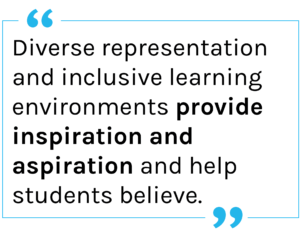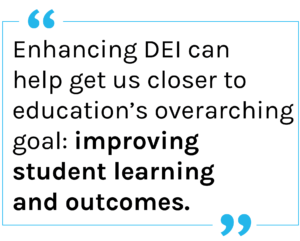What is DEI?
Updated March 2022
DEI stands for diversity, equity, and inclusion, and is an important topic in all industries today—including HigherEd. Many organizations consider DEI a priority when it comes to recruiting and hiring, advancement, and strategic decision-making.
Why is DEI important for higher education?
In the world of education, DEI is an especially relevant topic—and a unique one, because it doesn’t just involve employees. DEI is important in a student body, and it’s important for students to see DEI as a priority at their college or university.
For instance, it’s been shown that a focus on DEI in faculty recruitment can impact student outcomes at an institution. Diversity on campus improves cultural awareness and critical thinking. A diverse faculty body can offer a unique kind of support to students from historically underrepresented backgrounds.
According to Nancy Aebersold, founder and executive director of the Higher Education Recruitment Consortium (HERC), “Students benefit from seeing themselves mirrored in the front of the classroom. Diverse representation and inclusive learning environments provide inspiration and aspiration and help students believe, ‘I can be there, or I can achieve thought leadership in the profession I choose.’”
Improving Student Outcomes
DEI should be seen as “mission-critical” at higher education institutions. A diverse faculty and student body, along with an environment that promotes equity and inclusion of all voices, is the heart of education. Enhancing DEI can help get us closer to education’s overarching goal: improving student learning and outcomes.
“A diversity of perspectives produces a more energized and dynamic academic environment,” said Nancy Aebersold. “People with different life experiences ask different questions. They enrich dialogs and may ignite contestation or disruption of the status quo, which fuels the creation of new knowledge, innovation and deeper understandings.” But there are challenges. Nancy refers to DEI as one of the most “serious, complex, and nuanced” topics in higher education today.
dialogs and may ignite contestation or disruption of the status quo, which fuels the creation of new knowledge, innovation and deeper understandings.” But there are challenges. Nancy refers to DEI as one of the most “serious, complex, and nuanced” topics in higher education today.
“The greatest challenge is the demand for diverse Ph.D.s seeking faculty appointments far outweighs the supply,” she said. “To solve that, it will take time, strategic policy changes and resources.”
These pipeline issues can be complicated to solve. One study showed that female undergraduate students are more likely to take on leadership roles when female role models—like full professors—are present. It follows that if your STEM department hires more women in teaching roles, those faculty members will then inspire their female students, helping to bring even more diversity into STEM. But as Nancy notes, if the candidates don’t exist, it is difficult to hire them.
Problem-solving
There is always somewhere to start, however. One college wrote in Inside Higher Ed about a team diving deep into data to not just expand their DEI efforts, but to understand where those efforts are working—and where they aren’t. They developed a set of data points to understand where in a student, staff, or faculty member’s experience they might be likely to experience racial inequity and, in the process, realized they were lacking meaningful data about the faculty experience. The team recommended that the college start collecting that data to fully evaluate the college’s DEI culture. PeopleAdmin’s robust analytics capabilities can help your institution tackle these same challenges and gain actionable insights from complex, cross-campus data.
At Texas State University, the HR team has been utilizing PeopleAdmin’s software to empower a mover equitable hiring process. Applicant Tracking System simplifies the collection of equal opportunity employment (EE)O) data, while also streamlining search committee activities so that it’s easier to manage an unbiased selection process. The team now tracks EEO metrics to ensure that veterans, along with other protected classes, are represented in hiring pools and on campus. With PeopleAdmin’s tools, Texas State has improved their EEO response rate and can better monitor their employment goals.

Nancy Aebersold at HERC also acknowledges the importance of making DEI a priority for every member of your college or university, and that often needs to be achieved with professional development and continued learning. “There is a knowledge gap that needs to be filled by ‘educating the educators’ about barriers to inclusion,” she said. “The goal in addressing these issues through education, dialog and sharing of experiences is to create work and learning places that are safe, respectful, equitable and welcoming to all.”
Conclusion
DEI work is central to HigherEd today. Enhancing DEI across campus impacts students, faculty, and staff from every department. There are many ways to move your institution’s DEI initiatives forward, but technology and digitization are the first step. Contact us to learn how PeopleAdmin can help you proactively manage your DEI initiatives, attract diverse candidate pools, understand your faculty workloads, and boost student outcomes.